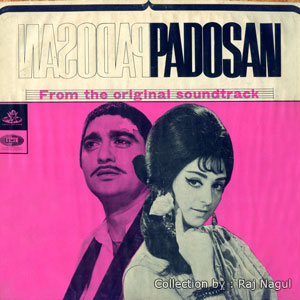Kehna Hain

Film: Padosan (1968)
Producer: Mehmood, N.C. Sippy
Director: Jyoti Swaroop
Lyricist: Rajendra Krishna
Singer: Kishore Kumar
“Before the assault of laughter nothing can stand” – Mark Twain.
Poor comedians of the Hindi cinema. Comedy by default has meant the slip ‘n fall downstairs, facial contortions, the pants coming undone during a chase-around-the-table, or a hiccupping guffaw of laughter. There were designated comedians who would appear and disappear on cue. The comedians’ screen image portrayed them as being low on talent and would be tagged marginal occupations like tel-malish wala and all that..
And then arrived Padosan with the two warring comedians endowed with exceptional talent. And the hero Bhola, a hopeless loser. But first, Rajender Krishan. He can look back and count two jackpots in his life – one was an Rs.46 lac win at the derby sometime in the 1970s. The other was Padosan. He wrote the screenplay, crafted the gag-a-minute dialogues in addition to filling out the lyrics in an album whose tracks ranged from Bhatiyali to Carnatic Classical to waltz.
Master Vidyapati (played by Kishore Kumar) was modelled on a real-life Bengali gentleman Shanu-babu, a maternal uncle of Kishore. King Kishore etched out a screen image of a comic that was beyond anybody’s emulation.
Master Vidyapati is a singer cum music teacher who wears a substantial mustache with its tail end twitched up briefly. His oiled hair is parted down the middle. Paan chewing and clothed in traditional white dhuti-panjabi, with one end of the dhuti tucked into the Panjabi pocket, he walked at a brisk pace with his 4-man cult following in tow. The unspoken suggests that Vidyapati has no love interest. Maybe there was some history of hurt to it. It briefly peeps out in Mere bhole balam, when, by a slip of tongue, he utters “Anuradha” instead of “Bindu”. Till he reaches the climatic song, Kehna hai.
Pancham builds the tune of Kehna hai on medium and long notes, sung in a mix of staccato and continuous styles. Simplicity being the buzz word in a song meant to be on traditional lines, Pancham, contrary to his evolving style of changing meters and rhythms within a song, keeps the flow in both the mukhra and the antara almost on similar lines. One does notice the Pancham’s trademark shift to the “off” in the bridge between antara on the way back to the mukhra (aaj magar bas itna hai karna hai ikrar).
Pancham models the song on waltz – given that the sequence was a happy public finale of Bindu’s acceptance of Bhola’s love for her. Strings and conventional waltz in Hindi films were kind of inseparable, and flowing group violins with caressing strokes of bongo brings a haze of mush about Bindu’s birthday party. Pancham uses violins as a sharp countermelody following the notes “tum hi”, “laayi”, and “jeevan”, which are, interestingly, on the same melodic note – Sa. The ‘Sa’ in the first chord becomes ‘Pa’ in one, and consequently ‘Ga’ in another! The violin ensemble continues building up the song; it literally carries the mukhra to the first antara.
Surely opposed to the conventional usage in which violins ‘followed’ the singer.
The build up in an optimistic soft-romantic Hindi film song is normally a progression of low notes followed by higher notes. The approach used in Kehna hai is different, in as much that the starting notes in both the mukhra and the antara are high, while the notes which follow are low. A subtle hint at the resignation to fate which was to follow perhaps?
In hindsight, the mellow feel of the number was the sharp contrast to the stomach-clutching laugh-riot that Padosan was. As Kehna hai rolls on, roses are thrown about, there are happy faces all around, we are ready for the customary “shehnai” shot and the “The End” message but….
…. on that grand ballroom-like occasion, another sub-plot takes a critical twist. Bindu’s friend is able to place a finger on Bhola’s voice at the opposite window. It sounded too familiar. She points out to a disbelieving Bindu. She grabs Bindu by the hand and leads her to the opposite house. A trapped Bhola dissolves into his hat. Vidyapati blissfully sings on. The song ends. Vidyapati turns and looks at Bindu’s friend.
She is Anuradha. We clutch our stomachs bracing for more.
PS : – How Padosan was made, the negative publicity it received, the film being declared a flop in Bombay, how Pancham was almost taken to court on account of contravening a rule … all probably deserve a separate chapter.
But unpardonable is the take of the media on the music then – lukewarm. Surely not a surprise when your surname is Burman.
Anirudha Bhattacharjee & Balaji Vittal
panchammagic.org

